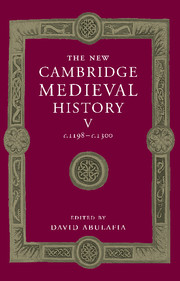Book contents
- Frontmatter
- Introduction
- Part I Common Themes
- Part II The Church in the Thirteenth Century
- Part III The Western Kingdoms
- Part IV Italy
- 15 Northern Italy
- 16 The kingdom of Sicily under the Hohenstaufen and Angevins
- Part V The Mediterranean Frontiers
- Part VI The Northern and Eastern Frontiers
- Appendix Genealogical tables
- Primary sources and secondary works arranged by chapter
- Index
- Plate section
- Map 1 Europe in the thirteenth century
- Map 3 France, c. 1260
- Map 5 Germany and the western empire
- Map 6 Genoa, Venice and the Mediterranean
- Map 8 The Latin empire of Constantinople and its neighbours
- Map 10 Aragon and Anjouin the Mediterranean">
- References
16 - The kingdom of Sicily under the Hohenstaufen and Angevins
from Part IV - Italy
Published online by Cambridge University Press: 28 March 2008
- Frontmatter
- Introduction
- Part I Common Themes
- Part II The Church in the Thirteenth Century
- Part III The Western Kingdoms
- Part IV Italy
- 15 Northern Italy
- 16 The kingdom of Sicily under the Hohenstaufen and Angevins
- Part V The Mediterranean Frontiers
- Part VI The Northern and Eastern Frontiers
- Appendix Genealogical tables
- Primary sources and secondary works arranged by chapter
- Index
- Plate section
- Map 1 Europe in the thirteenth century
- Map 3 France, c. 1260
- Map 5 Germany and the western empire
- Map 6 Genoa, Venice and the Mediterranean
- Map 8 The Latin empire of Constantinople and its neighbours
- Map 10 Aragon and Anjouin the Mediterranean">
- References
Summary
THE Sicilian kingdom, encompassing also the south of Italy, contained a great variety of lands, with distinctive economic, ethnic, religious and political characters. It was not as heavily urbanised as parts of the Po valley or northern Tuscany, though it contained two of Europe’s largest cities, Palermo and Naples, the former of which had become the capital under the Norman kings (1130–94), while Naples increasingly acquired the role of capital in the course of the thirteenth century, and stood close by the once vibrant commercial centres of the Amalfi coast. Apulia, facing the Balkans, contained a line of cities which were not permitted by the Normans to achieve true autonomy, but which could trade the wine, grain and olive oil of the Apulian plains for produce of the east. Further inland cities such as Lucera performed valuable roles as centres of administration, and L’Aquila emerged in the Abruzzi as a major border town, linking the economy and religious life of the northernmost parts of the Regno (as it is generally called: the kingdom) to the Umbrian world of Franciscan spirituality. In Sicily, there existed extensive grain-producing areas, which grew in importance during the late twelfth and early thirteenth centuries, as traditional Muslim agricultural skills were lost, and land which had been given over to specialised crops such as indigo and henna was converted into wheat land. Pastoral activities are also clearly documented, with Frederick II in 1231 legislating to ensure that the regular transhumance of sheep in Apulia did not give rise to strife. The emphasis was on the production of primary goods such as raw wool, hard wheat and olive oil; therefore, some historians have seen in this a sign that the Regno was in some sense underdeveloped. In the thirteenth century, the ready availability of staple goods was, rather, seen as a source of wealth to whichever would-be conqueror acquired control of the kingdom.
Information
- Type
- Chapter
- Information
- The New Cambridge Medieval History , pp. 498 - 522Publisher: Cambridge University PressPrint publication year: 1999
References
Accessibility standard: Unknown
- 3
- Cited by
